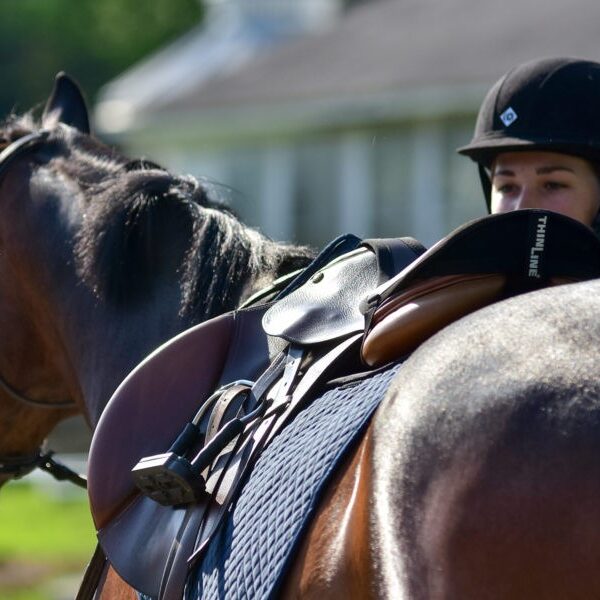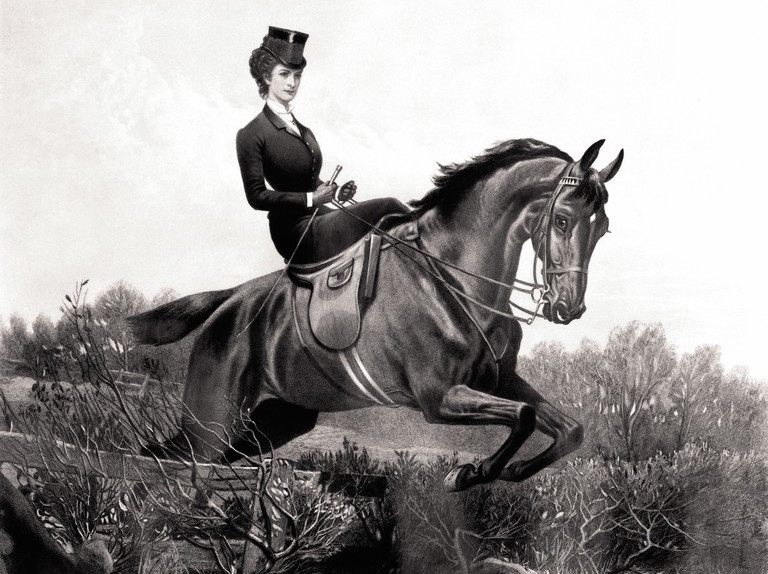Side saddle saddles offer a unique riding experience, historically designed for women’s modesty and elegance while riding. The saddle allows the rider to sit with both legs on one side of the horse, promoting a graceful and refined appearance.
Additionally, side saddle riding requires specific techniques and skills to ensure comfort and safety for both rider and horse. Riders use their seat bones differently, relying on precise balance and control. The design of these saddles is crucial to provide stability and support for the rider in this specialized riding style, making them different from traditional saddles.
Overall, side saddle saddles combine function and fashion to create a stylish and traditional equestrian experience.

History Of Side Saddle
The history of side saddles dates back to cultural traditions and norms that dictated how women should ride horses.
Cultural Origins Of The Side Saddle
Side saddles were originally developed in Europe due to cultural norms that deemed it inappropriate for women to straddle horses. This riding style was intended to preserve the appearance of aristocratic girls’ virginity by protecting the hymen.
Evolution Of The Side Saddle
Over time, side saddles evolved to be more comfortable and functional, catering to the needs of female riders. The design and construction of side saddles improved, enhancing both safety and elegance.
Significance Of Riding Side Saddle
- Riding side saddle was a way for women to maintain their modesty and uphold societal expectations.
- Side saddle riding required proper posture and balance, showcasing a rider’s grace and poise.
- Despite initial challenges, side saddle riding became a symbol of femininity and sophistication.
Types Of Side Saddles
Side saddles come in various types and styles, each designed to cater to different riding preferences and disciplines. Whether you are into English riding, Western riding, or seeking a custom or traditional side saddle, there is a saddle type that suits your needs.
English Side Saddle
English side saddles are popular for their elegance and traditional design. They are crafted to provide a secure and comfortable seat for riders in disciplines such as dressage, showing, and hunting. With a deep seat and high pommel, English side saddles offer stability and support during riding.
Western Side Saddle
Western side saddles exude a classic Western charm and are commonly seen in disciplines like Western pleasure and trail riding. These saddles feature a horn to provide additional security and stability for riders when navigating rough terrain. Western side saddles are known for their intricate tooling and decorative details.
Custom And Traditional Side Saddles
For those seeking a unique and personalized riding experience, custom side saddles are the way to go. Crafted to fit both the rider and the horse perfectly, these saddles offer unparalleled comfort and style. Traditional side saddles, on the other hand, reflect the heritage and craftsmanship of bygone eras, making them a favourite among collectors and history enthusiasts.
Choosing The Right Side Saddle
When it comes to side saddle riding, choosing the right saddle is crucial to ensure comfort, safety, and proper riding technique. Whether you are a beginner or an experienced rider, selecting the appropriate side saddle requires careful consideration of various factors, including the horse breed, saddle fit, and adjustments. In this guide, we’ll explore the essential aspects to consider when choosing the right side saddle, from identifying the best horse breeds for side saddle riding to understanding the importance of saddle fit and adjustments.
Factors To Consider
When it comes to selecting a side saddle, several important factors should be taken into account to ensure a comfortable and secure riding experience. These include:
- Personal comfort and riding style
- Material and construction of the saddle
- Weight and balance of the saddle
- Stability and security of the pommel
Best Horse Breeds For Side Saddle Riding
Not all horse breeds are equally suited for side saddle riding. Certain breeds are known for their graceful movements and calm temperaments, making them well-suited for this riding style. Some of the best horse breeds for side saddle riding include:
- Arabian
- Andalusian
- Connemara
- Haflinger
Saddle Fit And Adjustments
Ensuring proper saddle fit and adjustments is essential for both the rider’s comfort and the horse’s well-being. Factors to consider when fitting and adjusting a side saddle include:
- Proper measurement of the horse’s back
- Correct positioning and alignment of the saddle
- Adjustment of the stirrup length
- Even distribution of weight
“`
Riding Techniques And Challenges
Explore the intricacies of riding techniques and challenges involved in mastering the art of using side saddle saddles. Navigate through the cultural history and etiquette of Europe in adopting this specialized riding style, while also understanding the practicalities of its application and the suitable horse breeds to complement this elegant riding form.
Proper Riding Posture
When it comes to side saddle riding, proper posture is essential for maintaining balance and control. The rider must sit tall with a straight back, aligning the ears, shoulders, hips, and heels in a vertical line. The weight should be evenly distributed on both seat bones, creating a stable and secure position in the saddle. The rider’s legs should be draped elegantly over the horse’s side, with the right leg extended forward and the left leg positioned behind the leaping head. This posture not only ensures a graceful appearance but also allows the rider to communicate effectively with the horse through subtle weight shifts and cues.
Challenges Of Riding Side Saddle
Riding side saddle presents unique challenges compared to riding astride. One of the primary challenges is maintaining balance and stability. Without the ability to straddle the horse, side saddle riders must rely on the strength of their core muscles to stay centered and secure. This requires a great deal of core strength and stability. Additionally, side saddle riders face the challenge of adjusting to a different distribution of weight. Unlike astride riding, where the weight is evenly distributed on the horse’s back, side saddle riding places more weight on one side of the horse. This can affect the horse’s balance and may require additional training and conditioning for both the horse and the rider.
Training And Skill Development
Becoming proficient in side saddle riding requires dedicated training and skill development. Riders must undergo specialized lessons to learn the proper techniques and develop the necessary muscle memory. Core strength exercises and posture drills are crucial for building stability and balance. In addition to physical training, riders also need to familiarize themselves with the proper tack and equipment for side saddle riding. The choice of side saddle saddle is vital, as it needs to provide proper support and balance for the rider. Regular practice and consistent training are necessary to refine the rider’s skills and ensure a safe and comfortable ride.
With dedication and practice, riders can overcome the challenges of side saddle riding and embrace the elegance and tradition associated with this unique style of riding. By maintaining proper riding posture, understanding the challenges, and investing in training and skill development, riders can confidently embark on the journey of riding side saddle.
Side Saddle Accessories And Attire
Enhance your side saddle experience with exquisite accessories and attire. Elevate your style and comfort with specialized pommels, habits, and hats designed for side saddle saddles. Immerse yourself in the tradition with high-quality gear for a timeless equestrian pursuit.
Pommels
One of the most important side saddle accessories is the pommel. The pommel, also known as the leaping horn, is an essential component that helps provide stability and security to the rider. It is a curved, raised projection located at the front of the saddle, which allows the rider to maintain balance while riding in a side saddle position. The pommel comes in different shapes and sizes, depending on the rider’s preference and the type of riding activity. Some pommels are designed for showing, while others are more suited for hunting or general riding.
Habits
Another crucial aspect of side saddle attire is the habit. The habit refers to the traditional riding outfit worn by women when riding in a side saddle. It typically consists of a tailored jacket, usually in a dark color such as black or navy, paired with a long, flowing skirt that reaches the ankles. The skirt is specially designed to accommodate the side saddle position, allowing the rider to sit comfortably and elegantly. Additionally, habits are often adorned with decorative elements such as intricate embroidery or lace, adding a touch of grace and sophistication to the overall look.
Riding Hats
When it comes to side saddle attire, a proper riding hat is of utmost importance. The riding hat serves not only as a stylish accessory but also as a crucial safety measure. It protects the rider’s head in case of a fall or accident, minimizing the risk of head injuries. Riding hats are designed to be lightweight, comfortable, and secure, ensuring that they stay in place even during active riding. They come in various styles and designs to suit different tastes and preferences. Whether it be a classic riding cap or a more modern helmet, a riding hat is a must-have accessory for any side saddle rider.
Recommended Riding Attire
Now that we have covered pommels, habits, and riding hats, let’s talk about the overall recommended riding attire for side saddle enthusiasts. In addition to the essentials mentioned above, it is important to wear suitable clothing that allows for freedom of movement and comfort while riding. This typically includes a well-fitted shirt or blouse, riding breeches or jodhpurs, and appropriate footwear, such as riding boots or shoes with a low heel. It is also advisable to opt for accessories like gloves to enhance grip and protect the hands during riding. By adhering to these recommendations, riders can ensure both style and practicality while enjoying their side saddle experience.
Essential Side Saddle Accessories
In addition to the pommel, habit, and riding hat, there are several other essential accessories that every side saddle rider should have. These accessories include:
- A balance strap or handlebar, which provides additional stability and support to the rider. It can be attached to the pommel and allows the rider to maintain a secure grip.
- A safety stirrup, designed to release the rider’s foot in the event of a fall, minimizing the risk of getting caught in the stirrup.
- A side saddle apron, a detachable garment that covers the rider’s legs and provides additional protection and modesty.
- A saddle cover, which helps protect the saddle from dirt, dust, and moisture when not in use.
- Decorative accessories such as saddlebags, saddle blankets, and decorative browbands, which add a touch of personal style.
- A whip or cane, which is used for communication and subtle aids while riding.
These accessories not only enhance the overall appearance of the rider but also contribute to the safety and functionality of the side saddle experience. By investing in these essential accessories, riders can enjoy a comfortable and stylish ride while adhering to the traditions and etiquette of side saddle riding.


Frequently Asked Questions On Side Saddle Saddles
What Is The Point Of Riding A Side Saddle?
Riding side saddle was initially to adhere to cultural norms where women didn’t straddle horses, preserving appearance and modesty.
Is Riding Side Saddle Harder?
Riding side saddle is challenging due to the asymmetrical position, relying more on seat bones, and different use of lower back and abs.
Is Sidesaddle Bad For Horses?
No, sidesaddle is not bad for horses if the saddle fits properly and the rider is positioned correctly. Perfect form while riding sidesaddle requires skill, but it is no worse for the horse’s back than riding astride. There are no additional benefits to riding sidesaddle compared to astride.
What Kind Of Horse Is Best For A Side Saddle?
The best horse for a side saddle is one that is well-trained, has a calm temperament, and a smooth gait.
Conclusion
After mastering the elegance of side saddle riding, it’s important to choose the right saddle for the ultimate riding experience. Finding the perfect balance of comfort and functionality is key. With the right information, you can select the ideal side saddle to suit your needs and complement your riding style perfectly.

